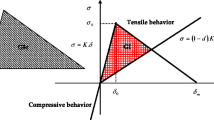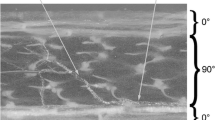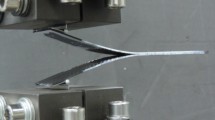Abstract
The experimental effort required to develop, damage tolerant, aerospace composite structures could be significantly reduced if reliable numerical simulations were used to perform engineering studies of complex damaged structures. Finite element (FE) simulations of impact damaged structures typically follow a sequential approach that require large computational resources to reproduce complex damage scenarios. A numerical tool capable to reconstruct such scenarios using data from previous impact simulations or NDI could noticeably improve the simulation workflow for damaged composite structures. The paper proposes a method to inizialize the damage variables in numerical analyses aimed at assessing damage propagation, and that are potentially able to evaluate the residual strength of damaged structures. The approach is developed within FE software ABAQUS, and uses SDVINI subroutine to initialize damage variables defined by a user-material-subroutine (UMAT), that provides the constitutive models of the lamina and of the interlaminar layers. Albeit the proposed technique might deal with both inter-laminar and intra-laminar damage, the paper is focused on delaminations. A user defined traction-separation law is coded in an UMAT that endows ABAQUS cohesive elements with damage initialization capabilities. Then, results of test cases, of increasing complexity, are presented in order to assess the damage initialization procedure and verify the performances of its different operating modes. Two test-cases are based on plate-like specimens for which literature data exist: the first is relevant to a circular artificial delamination while the second presents multiple delaminations caused by an impact and measured via NDI techniques. The last test-case is a stiffened panel which incorporates the typical complexities of aerospace structures, but is still tractable with the sequential simulation approach whose results are used as a term of comparison.












Similar content being viewed by others
Notes
The damage initialization method developed in the paper can be extended to any constitutive cohesive law by modifying the UMAT appropriately.
Macauley brackets \(\left\langle {\cdot } \right\rangle \) are defined so that: \(\left\langle x \right\rangle = {{\left( {x + \left| x \right| } \right) /2} }\).
In order to avoid numerical problems during implicit simulations that do not allow the removal of completely damaged elements, a very small stiffness is retained. Dedicated checks of the results can easily confirm that such residual stiffness does not affect the results of the analyses.
ABAQUS CAE assigns unique element IDs within a part instance, only at runtime unique element IDs are assigned within the whole model.
In the current version the two models need to be identical in the areas interested by damage but can differs in terms of active part instances and boundary conditions.
References
U.S. Department of Defense (2002) Composite materials handbook, vol 1–4 F. MIL-HDBK-17 rev F
Davies G, Ankersen J (2008) Virtual testing of realistic aerospace composite structures. J Mater Sci 43:6586–6592. doi:10.1007/s10853-008-2695-x
Donadon MV, Iannucci L, Falzon BG, Hodgkinson JM, De Almeida SFM (2008) A progressive failure model for composite laminates subjected to low velocity impact damage. Comput Struct 86:1232–1252
Tita V, de Carvalho J, Vandepitte D (2008) Failure analysis of low velocity impact on thin composite laminates: experimental and numerical approaches. Compos Struct 83(4):413–428
Lopes CS, Camanho PP, Grdal Z, Maim P, Gonzlez EV (2009) Low-velocity impact damage on dispersed stacking sequence laminates. Part II: numerical simulations. Compos Sci Technol 69:937–947
Faggiani A, Falzon BG (2010) Predicting low-velocity impact damage on a stiffened composite panel. Compos Part A Appl Sci Manuf 41:737–749
Shi Y, Swait T, Soutis C (2012) Modelling damage evolution in composite laminates subjected to low velocity impact. Compos Struct 94(9):2902–2913
Raimondo L, Iannucci L, Robinson P, Curtis PT (2012) A progressive failure model for mesh-size-independent FE analysis of composite laminates subject to low-velocity impact damage. Compos Sci Technol 72(5):624–632
Feng D, Aymerich F (2014) Finite element modelling of damage induced by low-velocity impact on composite laminates. Compos Struct 108:161–171. doi:10.1016/j.compstruct.2013.09.004
Fanteria D, Longo G, Panettieri E (2014) A non-linear shear damage model to reproduce permanent indentation caused by impacts in composite laminates. Compos Struct 111:111–121
Camanho PP, Davila CG, de Moura MF (2003) Numerical simulation of mixed-mode progressive delamination in composite materials. J Compos Mater 37:1415–1438. doi:10.1177/002199803034505
Turon A, Camanho PP, Costa J, Dvila CG (2006) A damage model for the simulation of delamination in advanced composites under variable-mode loading. Mech Mater 38:1072–1089. doi:10.1016/j.mechmat.2005.10.003
Turon A, Dvila CG, Camanho PP et al (2007) An engineering solution for mesh size effects in the simulation of delamination using cohesive zone models. Eng Fract Mech 74:1665–1682. doi:10.1016/j.engfracmech.2006.08.025
Dvila C, Camanho P, Turon A (2008) Effective simulation of delamination in aeronautical structures using shells and cohesive elements. J Aircr. doi:10.2514/1.32832
Turon A, Camanho P, Costa J, Renart J (2010) Accurate simulation of delamination growth under mixed-mode loading using cohesive elements: definition of interlaminar strengths and elastic stiffness. Compos Struct 92:1857–1864. doi:10.1016/j.compstruct.2010.01.012
Wisnom MR (2010) Modelling discrete failures in composites with interface elements. Compos Part A Appl Sci Manuf 41:795–805. doi:10.1016/j.compositesa.2010.02.011
Longo G (2011) Models and methods to simulate low-energy impact damage on composite aerospace structures. Ph.D. Thesis, University of Pisa
Dassault Systemes Simulia Corp. (2014) Abaqus 6.13 user’s manual
Harper PW, Sun L, Hallett SR (2012) A study on the influence of cohesive zone interface element strength parameters on mixed mode behaviour. Compos Part A Appl Sci Manuf 43:722–734. doi:10.1016/j.compositesa.2011.12.016
Song K, Davila C, Rose C (2008) Guidelines and parameter selection for the simulation of progressive delamination. ABAQUS Users’ Conference, Newport
Reeder JR, Chunchu PB, Song K, Ambur DR (2002) Postbuckling and growth of delaminations in composite plates subjected to axial compression, 43rd AIAA/ASME/ASCE/AHS/ASC structures, structural dynamics, and materials conference
De Freitas M, Reis L (1998) Failure mechanisms on composite specimens subjected to compression after impact. Compos Struct 42:365–373
Dugdale DS (1960) Yielding of steel sheets containing slits. J Mech Phys Solids 8:100–104
Barenblatt G (1962) The mathematical theory of equilibrium cracks in brittle fracture. Adv Appl Mech 7:55–129
Schellekens JCJ, de Borst R (1992) On the numerical integration of interface elements. Int J Numer Methods Eng 36:43–66
Benzeggagh ML, Kenane M (1996) Measurement of mixed-mode delamination fracture toughness of unidirectional glass/epoxy composites with mixed-mode bending apparatus. Compos Sci Technol 49:439–49
American Society for Testing and Materials Standard Test Method for Mode I Interlaminar Fracture Toughness of Unidirectional Fiber-Reinforced Polymer Matrix Composites. ASTM D5528–01
American Society for Testing and Materials Standard Test Method for Mixed Mode I - Mode II Interlaminar Fracture Toughness of Unidirectional Fiber-Reinforced Polymer Matrix Composites. ASTM D6671/D6671M-06
Author information
Authors and Affiliations
Corresponding author
Rights and permissions
About this article
Cite this article
Panettieri, E., Fanteria, D. & Firrincieli, A. Damage initialization techniques for non-sequential FE propagation analysis of delaminations in composite aerospace structures. Meccanica 50, 2569–2585 (2015). https://doi.org/10.1007/s11012-015-0214-0
Received:
Accepted:
Published:
Issue Date:
DOI: https://doi.org/10.1007/s11012-015-0214-0




